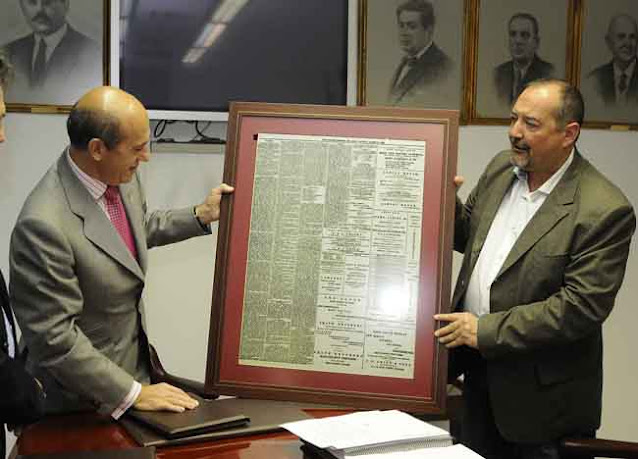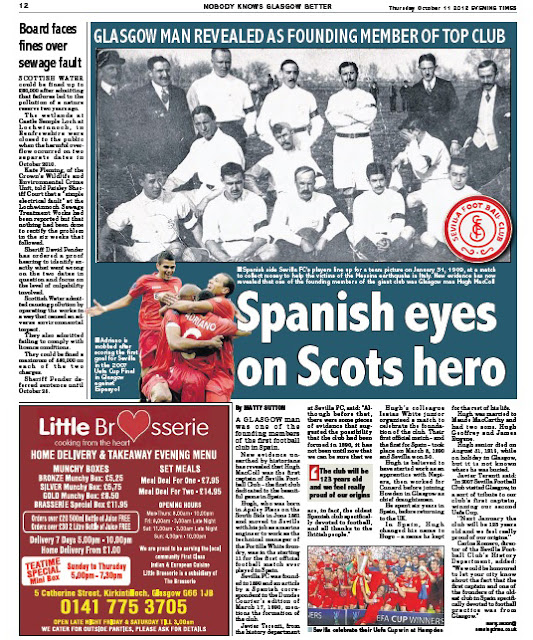Back in October 2012, we published a story on the blog about how the History Dept at Sevilla Football Club had discovered an article in the BNA that proved their club was much older than had previously been thought.
Indeed, the newspaper article proved that Sevilla FC was the oldest football club in Spain, and the club considers the newspaper article that they discovered in the BNA as its founding document.
Given the importance of the newspaper article in the story of the club’s history, the club’s History Department decided they would like a copy of the historic page to hang in their football museum.
Very kindly, these modern-day ‘Sevillistas’ have sent us a photograph of the ceremony which saw the print handed over to the Club President. Further, they have written a short article (included below) that explains the ceremony – watch out for the lyrical phrase, ‘A newspaper is a paper bird flapping in the window of history’.
 |
| Pictured left to right are José María del Nido, Club President, and Carlos Romero, Director of the History Department at Sevilla FC |
The president of Sevilla FC, Mr. José María del Nido, was presented on the 25th of January 2013, at the very heart of the Ramon Sanchez Pizjuan stadium by the club’s History Department, with a copy certified by the British Newspaper Archive of the fourth page of the Dundee Courier edition of March 17, 1890. The page in question contains a treasure for the history of Spanish football, since it is an article that describes in detail how the club was founded 15 years earlier than it was thought, thus being Spain’s oldest football club. In fact, that article can be considered the founding document of Sevilla FC.
The article that is extremely rich in details shows how the club’s founding date was not a coincidence. Everything suggests that that Saturday 25 January, 123 years ago, a group of young British, mainly Scots, along with other young men of Spanish origin, certainly had something to celebrate. They did not work that evening in order to meet at one of the cafes in the city and celebrate Burns Night with the excuse of founding the first football club in Spain. Among the most prominent Scots were their first president, EF Johnston, and the first captain, Hugo Maccoll, who later, upon returning to UK chaired the Sunderland Burns Club. Coincidentally, whereas football was born in Framason’s Tavern, Sevilla Football Club was born in a cafe in Seville.
The discovery of the club’s Act of Constitution within an old edition of the Dundee Courier, has supposed great news which has been published not only in Spain but also in several important newspapers outside the country. The importance of the treasure found in the British Newspaper Archive for Spanish football can be clearly reflected in the speech pronounced by Mr Carlos Romero, director of the Club’s History Department, to Sevilla FC’s president during the event, when he quoted the Spanish reporter Ignacio Camacho on the occasion of a prestigious journalism award:
“A newspaper is a paper bird flapping in the window of history.”
Then, Mr. Carlos Romero followed:
“A Scottish gannet appeared at our window, carrying in its beak an old newspaper, The Dundee Courier edition of March 17, 1890, which was our founding date.
Thanks to “The British Newspaper Archive” of the British Library, within whose documentary collection, in the magnificent archive that this institution has provided online, we discovered the copy that was fluttering at our window.
It’s a beautiful article that chronicles the adventures of those first ‘sevillistas’, in which the following paragraph appears:
‘Some six weeks ago a few enthusiastic young residents of British origin met in one of the cafés for the purpose of considering a proposal that we should start an Athletic Association, the want of exercise being greatly felt by the majority of us, who are chiefly engaged in mercantile pursuits. After a deal of talk and a limited consumption of small beer, the “Club de Football de Sevilla” was duly formed and office-bearers elected. It was decided we should play Association rules (…) We were about half and half Spanish and British’
Along with the club’s act of constitution found in the BNA, the different members of the club’s History Department also presented the president with a complete dossier of 400 pages with the result of eight years of work researching the origins of the club in 1890.
Published by The British Newspaper Archive





